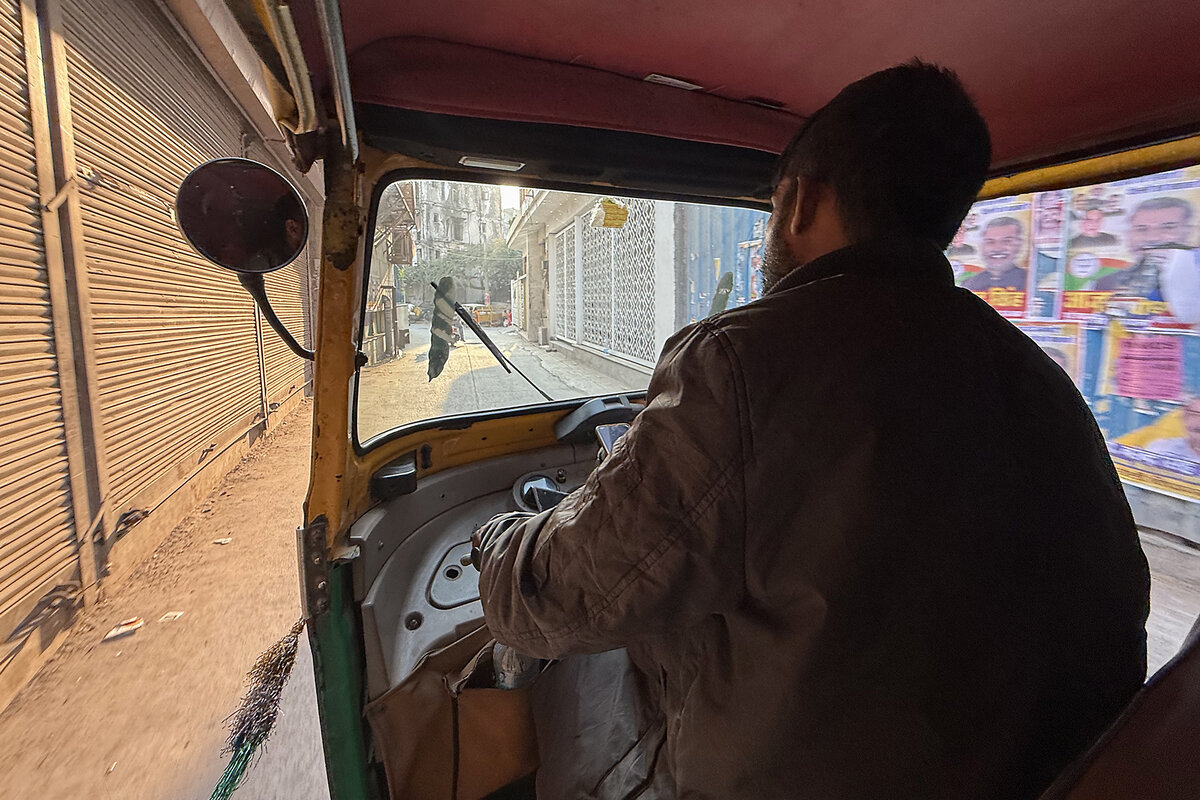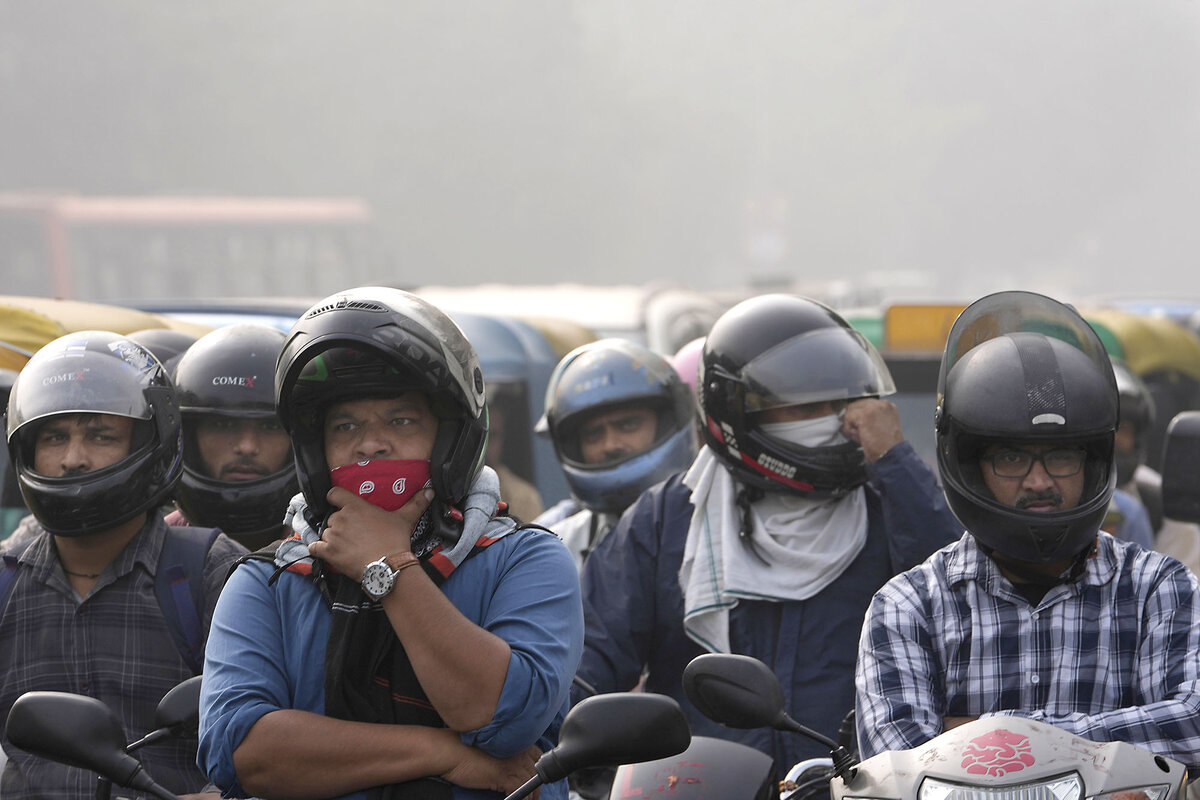In Delhi, life beats on under toxic smog. But residents say this year is different.
| New Delhi
Yogesh Desh Bhakar has been driving his green-and-yellow auto rickshaw down the jampacked streets of Delhi for the last five years, pushing his way through the wall of smog that closes in on the capital each winter.
But this year is unlike any that residents recall.
There are days Mr. Bhakar has struggled to breathe. The smoky odor clings to his clothing, and his eyes burn as he waits for passengers late at night, when the smog thickens. Glancing up at Delhi’s high-rise buildings, only a handful of lit-up windows break through the gray haze.
Why We Wrote This
Delhi's air pollution is among the worst in the world, far exceeding World Health Organization safety limits. Residents share what that feels like for them on the ground.
The pollution levels in India’s capital rose to “severe plus” last week, meaning the air is considered hazardous to otherwise healthy people, even after brief exposure. Yet life hasn’t paused here as it did in parts of eastern North America in the summer of 2023 when wildfire smoke caused some summer camps to shut down and authorities suggested Americans and Canadians stay indoors. Indian officials recommended the same on Nov. 17, especially for the elderly. But most Indians don’t have that luxury.
“I can’t stop going to work,” says Mr. Bhakar, who lives in southern Delhi’s Mehrauli neighborhood along with his wife and two children. “I have to earn for my family.”
That doesn’t mean that residents want life to go on as usual, especially after this season. Delhi’s rising pollution – credited to winter smog, industrial emissions, vehicular exhaust, and stubble burning in nearby states – is disrupting daily life and impacting public health. According to 39 Monitoring centers that record pollution across the city, there hasn’t been a single day of healthy air this year. It’s no longer tenable, say city residents.
“New buildings are being constructed, vehicles are increasing, trees are getting cut everyday in Delhi,” says Mr. Bhakar. He and other Indians want the government to focus on the root problems, not quick fixes for severe smog.
Hospitals under strain
As the world debates complex financial systems and mitigation efforts to curb climate change, communities in India are still dealing with an immediate environmental crisis many in the West have forgotten about: toxic air.
In Delhi, the smog season generally peaks from October to January, and many in the city of 33 million power through without so much as donning a mask. But in recent weeks, the smog has become hard to ignore.
There is 10-year-old Bhavna Sharma, who instead of being in class was taken to an emergency room after she complained of a cough and chest pain. Shivam Singh Chohan would typically be picking up shifts in a bustling Delhi restaurant, but on a recent day he’s stuck in the courtyard of a crowded hospital, waiting for a ride home after tests for similar symptoms – things he never experienced before this year.
Dhruvil Gandhi, a postgraduate doctor at the National Institute of TB and Respiratory Diseases in Delhi, says with increased pollution levels – exacerbated by events like Diwali, a Hindu festival of lights when residents burst firecrackers despite a government ban – hospitals are seeing a surge in respiratory illness.
“This pollution is getting worse every year,” he says, straining the city’s healthcare system.
The government has imposed temporary restrictions on entry of trucks into the city, construction and demolition activities are suspended, schools have limited in-person classes, and offices are advised to operate with 50% staff to reduce commuting. But many criticize these measures as reactive and superficial, designed to mitigate the impacts of smog in a crisis, but not to address the source of Delhi's pollution problem.
Long-term solutions
Delhi isn’t the only city to deal with periods of toxic air. Beijing made headlines a decade ago for its polluted air but has since made vast improvements – while Delhi's air pollutant levels have exceeded China's worst levels.
The Chinese capital slashed pollution levels by relocating coal-fired power plants outside city limits. Before 2008 they had been responsible for 70% of Beijing's emissions.
But in many ways Delhi’s problems are tougher, and need a more holistic solution, says Dr. Gufran-Ullah Beig, a professor at the National Institute of Advanced Studies in Bangalore.
Here, key contributors such as transport emissions are mobile and difficult to contain, meaning mitigation will require large-scale transitions to electric or natural gas-based systems.
Professor Sachchida Nand Tripathi, dean of Kotak School of Sustainability at Indian Institute of Technology in Kanpur, agrees that India needs to fast track its clean energy shift, while also improving waste management and emissions monitoring systems.
Dr. Beig hopes this season is a wake-up call for authorities tasked with tackling Delhi’s escalating air pollution. The city needs a long-term plan, he says, implemented throughout the year – not just when air quality plummets.
“We need to work on a war footing,” says Dr. Beig.








